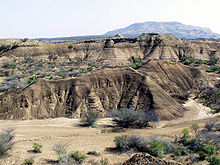Ethiopia is considered the area from which anatomically modern humans emerged.[1] Archeological discoveries in the country's sites have garnered specific fossil evidence of early human succession, including the hominins Australopithecus afarensis (3.2 million years ago) and Ardipithecus ramidus (4.4 million years ago). Human settlements in present-day Ethiopia began at least in the Late Stone Age, and the agricultural revolution took place in the third millennium BCE. Ethnolinguistic groups of Afroasiatic speakers (namely Semitic, Cushitic, and Omotic) and Nilo-Saharan speakers—defined by new ethnic, cultural, and linguistic identities—emerged around 2000–1000 BCE.

- ^ Mcdougall, I.; Brown, H.; Fleagle, G. (Feb 2005). "Stratigraphic placement and age of modern humans from Kibish, Ethiopia" (PDF). Nature. 433 (7027): 733–36. Bibcode:2005Natur.433..733M. doi:10.1038/nature03258. PMID 15716951. S2CID 1454595.
